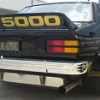Well I for one miss you posting, Ray, they're (almost) always good conversation starters! 
To expand (no pun intended) on what Lee said, there are generally three types of tank: overflow (aka expansion) tank; recovery tank; and header tank. It sounds like they've designed the tank you bought to do any of the above jobs, assuming it's able to be pressurised of course?
The hookup is basically the same for the first two types, a non-collapsible hose from the radiator 'overflow' to the bottom port of the tank, and a drain hose from the top side port down under the car somewhere (venting to atmosphere).
Then, the difference between the two systems is the type of radiator cap you have fitted, if it has the old-school cap with just one (lower) seal then it will act as an overflow tank. If the cap has two seals (one below & one above where the hose comes off the radiator), then your tank will act as a recovery tank.
Operationally the difference is that both types will expel a little coolant into the tank when the engine warms up for the first time, but then when it cools again, the old-school cap will suck in a little air and you will find the coolant level in the radiator remains about half an inch below the top every time you check it.
Adding the second (top) seal on the radiator cap means it can no longer suck air back in when cooling down, so instead it sucks coolant back out of the recovery tank. This is why the hose from the radiator must be non-collapsible (within reason) and terminate below the level of the coolant in the tank, otherwise it will suck air into the radiator.
Because the circuit between the radiator overflow and the tank is (theoretically) air-tight, the tank doesn't have to be above the radiator level, the drop in pressure (lets call it a vacuum) created will do the job instead of gravity and if all is well it will only ever suck air if the tank runs dry.
The third type of tank, the header tank, is more an integral part of the cooling system itself. They are pressurised and typically full flow, being somewhere in the actual coolant circuit. These kind of systems will often have the radiator cap on the header tank itself and may even have an additional recovery tank running off that.
In this scenario a header tank does need to be above the radiator level, or to be more specific, the radiator cap should be the highest part of the system so any air finds its way there and gets expelled as pressure builds, although many systems have some kind of bleeder setup but that's a story for another day.
Edited by Bigfella237, 09 August 2019 - 04:21 AM.















